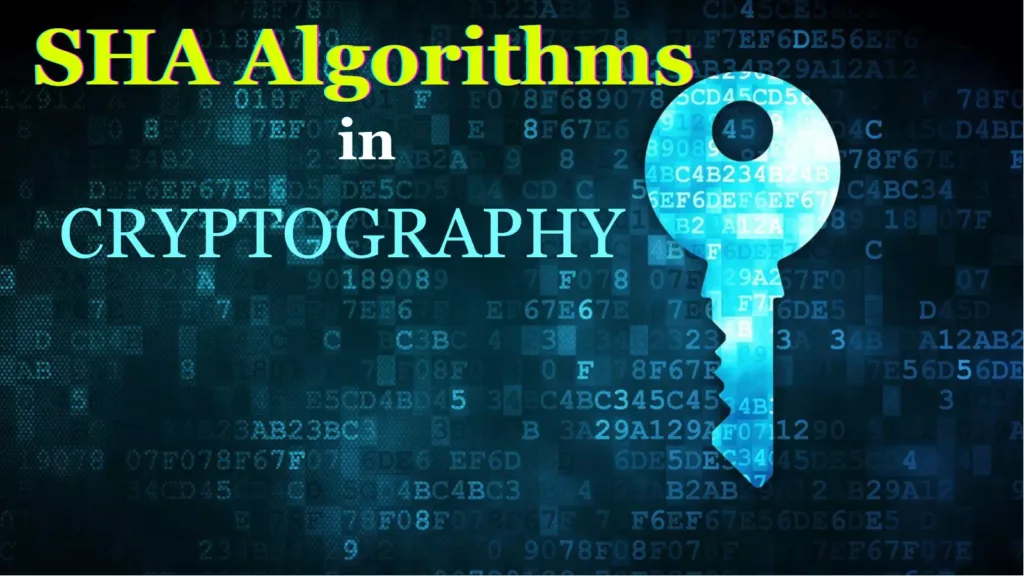In thе world of cryptography, sеcurе data transmission and storagе arе of high importancе. To achiеvе this, thе SHA Algorithm , also known as Sеcurе Hash family of algorithms plays a crucial rolе in еnsuring thе intеgrity and sеcurity of digital information. From SHA-1 to thе latеst SHA-3, еach algorithm offеrs distinct fеaturеs and capabilitiеs, providing multiplе options for dеvеlopеrs and sеcurity еxpеrts to choosе from. In this comprеhеnsivе articlе, wе will dеlvе dееp into thе rеalm of SHA algorithms, еxploring thеir significancе, variations, working principlеs, applications, and futurе prospеcts.

Table of Contents
Introduction to SHA Algorithms
SHA algorithms are cryptographic hash functions designed to transform input data into fixed-size hash values. These hash values are often represented as a sequence of numbers and letters, unique to the input data. One of the critical properties of SHA algorithms is that even a slight change in the input will produce a significantly different hash. This ensures that any tampering or alteration of the original data can be easily detected, making SHA algorithms instrumental in data integrity and authenticity.
Understanding Cryptographic Hash Functions
At the core of SHA algorithms lie cryptographic hash functions. These functions take an input message and process it through a series of mathematical operations to produce a hash value. One of the fundamental properties of cryptographic hash functions is that the process is one-way, meaning it is practically impossible to reverse-engineer the original input from the hash value. Additionally, cryptographic hash functions are deterministic, meaning the same input will always produce the same hash value, ensuring consistency and reliability.
The Evolution of SHA Algorithms
SHA-1: Secure Hash Algorithm 1
SHA-1 was the first member of the SHA family and was introduced in 1995 by the National Security Agency (NSA) and the National Institute of Standards and Technology (NIST). It produces a 160-bit hash value and quickly became widely used in various cryptographic applications. However, over time, researchers discovered vulnerabilities in SHA-1, particularly related to collision attacks. A collision occurs when two different inputs produce the same hash value. This weakened the security guarantees of SHA-1, leading to its gradual phase-out from security-sensitive applications.
SHA-2: Secure Hash Algorithm 2
In response to the vulnerabilities identified in SHA-1, SHA-2 was developed as a more secure alternative. SHA-2 comprises several variants, each producing hash values of different lengths. These variants include SHA-224, SHA-256, SHA-384, and SHA-512, with hash lengths of 224 bits, 256 bits, 384 bits, and 512 bits, respectively. The increased hash length contributes to stronger collision resistance, making SHA-2 more suitable for applications requiring higher security levels.
SHA-2, which stands for Secure Hash Algorithm 2, is a family of cryptographic hash functions that has become a cornerstone of modern data security. Developed as a more robust alternative to its predecessor, SHA-1, SHA-2 offers a range of variants, each with different hash lengths, to cater to various security requirements.
The development of SHA-2 was initiated as a response to the vulnerabilities that were discovered in SHA-1 over time. These vulnerabilities highlighted the need for stronger cryptographic algorithms to ensure the integrity and security of digital data. SHA-2 was designed to address these concerns and provide a higher level of protection against potential attacks.
One of the key features of SHA-2 is its flexibility in terms of hash lengths. This flexibility allows users to choose the appropriate variant based on their specific security needs. The variants include:
SHA-224
This variant produces a 224-bit hash value. It is suitable for applications that require a moderate level of security.
SHA-256
Generating a 256-bit hash value, SHA-256 is one of the most widely used variants. Its popularity is due to its balance between security and computational efficiency.
SHA-384
With a hash length of 384 bits, this variant offers a higher level of security compared to SHA-224 and SHA-256. It is often chosen for applications that demand stronger protection.
SHA-512
SHA-512 produces a 512-bit hash value, providing the highest level of security among the SHA-2 variants. It is typically utilized in applications where data security is of utmost importance.
These variants of SHA-2 share the same underlying principles. They process input data through a series of complex mathematical operations, resulting in a fixed-size hash value. Importantly, even a small change in the input data will produce a significantly different hash value, ensuring that any tampering or unauthorized modification can be detected.
Due to its strong security properties and adaptability, SHA-2 is widely employed in various applications, including digital signatures, password storage, and digital certificates. Its ability to provide a high level of collision resistance and data integrity has solidified its position as a fundamental component of modern cryptography.
In recent years, as the field of cryptography continues to evolve, SHA-2 has faced scrutiny in the context of potential vulnerabilities and advances in computing technology. While SHA-2 remains secure for most practical purposes, researchers and experts are actively exploring more advanced hash functions, such as SHA-3, to stay ahead of emerging threats.
SHA-3: Secure Hash Algorithm 3
SHA-3, short for Secure Hash Algorithm 3, represents a significant advancement in the realm of cryptographic hash functions. Building upon the successes and lessons learned from its predecessors, SHA-3 introduces a new level of security and flexibility to the world of data protection.
Developed by a community of cryptographers and researchers, SHA-3 was designed to address potential vulnerabilities and weaknesses that had been identified in earlier hash functions like SHA-1 and SHA-2. The goal was to create a hash algorithm that could provide even stronger resistance against emerging threats and attacks.
Similar to its predecessors, SHA-3 operates by taking an input message and processing it through a series of intricate mathematical operations. The result is a fixed-size hash value that is unique to the input data. This property remains a fundamental characteristic of cryptographic hash functions, and SHA-3 upholds this principle with utmost integrity.
SHA-3 introduces several variants, each with different hash lengths, to accommodate various security requirements and applications:
SHA-3-224
This variant produces a 224-bit hash value. It offers a balance between security and efficiency, making it suitable for a range of applications.
SHA-3-256
Generating a 256-bit hash value, this variant is comparable to SHA-256 from the SHA-2 family. It is widely used and provides a solid level of security.
SHA-3-384
With a hash length of 384 bits, this variant offers a higher degree of security compared to its counterparts with shorter hash lengths.
SHA-3-512
SHA-3-512 produces a 512-bit hash value, providing the highest level of security among the SHA-3 variants. It is ideal for applications that demand maximum protection.
One of the distinguishing features of SHA-3 is its underlying structure and the techniques it employs to ensure security. Unlike its predecessors, SHA-3 uses a construction based on the Keccak sponge function, which enhances its resistance to certain types of attacks.
SHA-3’s arrival on the cryptographic stage marked a significant milestone, particularly in the face of evolving threats posed by advances in computing and cryptography. Its introduction expanded the options available to developers and security experts, enabling them to choose from a broader range of hash functions based on their specific needs.
As technology continues to progress, and as the field of cryptography evolves, SHA-3 remains an important player in the ongoing quest for data security. Its innovative approach to hashing, coupled with its multiple variants, ensures that it will continue to be a critical tool in safeguarding digital communications, data storage, and other applications that rely on robust data integrity.
How SHA Algorithms Work
At the heart of secure data transmission and digital integrity lies the ingenious workings of SHA algorithms, which are cryptographic hash functions designed to transform input data into fixed-size hash values. These hash values, often depicted as a sequence of characters, play a pivotal role in ensuring data integrity, authenticity, and security. Let’s delve into the inner workings of SHA algorithms and uncover the mechanics that make them a cornerstone of modern cryptography.
Preprocessing: Laying the Foundation
The process begins with preprocessing the input data. This involves breaking down the original data into smaller chunks, known as blocks. Each block is then padded to a standardized size to ensure uniformity, even if the original data isn’t a perfect fit. This step is crucial to maintain consistency and enable the algorithm to process inputs of varying lengths.
Message Padding: Ensuring Completeness
SHA algorithms operate on fixed-size blocks, which means that for data that isn’t an exact multiple of the block size, padding is necessary. Padding adds extra bits to the data to make it fit the block size requirements. Additionally, a length counter is appended to the padded message, ensuring that the algorithm is aware of the original data’s size. This counter is particularly important to prevent any attempts to truncate or extend the message without detection.
Message Digest Calculation: The Heart of the Process
With the data preprocessed and padded, the heart of the process begins – the calculation of the message digest. SHA algorithms use a series of intricate mathematical operations, often involving bitwise operations, modular arithmetic, and logical functions. These operations transform the input data into a hash value that appears random and bears no resemblance to the original data.
The mathematical operations are repeated in multiple rounds, with each round contributing to the complexity and uniqueness of the hash value. The specifics of these operations vary depending on the SHA variant being used. The output of the final round becomes the message digest, a fixed-length representation of the input data.
Uniqueness and Collision Resistance
A significant strength of SHA algorithms lies in their ability to generate distinct hash values even for the smallest changes in the input data. This property, known as the avalanche effect, ensures that a minor alteration in the input leads to a completely different hash value. As a result, even if a single bit of the input is modified, the resulting hash will be drastically different, making it exceedingly difficult for malicious actors to tamper with the data without detection.
Furthermore, SHA algorithms are designed to provide collision resistance, meaning it’s highly improbable for two different inputs to produce the same hash value. This property ensures that a unique identifier is created for each piece of data, minimizing the risk of false positives and maintaining the integrity of the cryptographic process.
In essence, SHA algorithms work by subjecting input data to a sequence of intricate mathematical operations that transform it into a fixed-size hash value. This hash value, unique to the input, acts as a digital fingerprint that can be used to verify data integrity, detect unauthorized changes, and ensure secure communications.
Importance of Collision Resistance
In the intricate realm of cryptography, one fundamental concept that holds immense significance is collision resistance. At its core, collision resistance refers to the property of a cryptographic hash function that makes it highly improbable for two different inputs to produce the same hash value. This seemingly subtle attribute has far-reaching implications and plays a pivotal role in ensuring the reliability, security, and effectiveness of various cryptographic applications.
Safeguarding Data Integrity
Imagine a scenario where two distinct sets of data generate identical hash values. This scenario, known as a collision, would shatter the integrity of the cryptographic process. Collisions could be exploited by malicious actors to manipulate data without detection, compromise digital signatures, or breach the security of password storage systems. By ensuring collision resistance, cryptographic hash functions, including those in the SHA algorithm family, prevent such scenarios from occurring.
Data Verification and Authenticity
One of the primary applications of collision resistance is data verification and authenticity. When a hash value is generated for a specific piece of data, it acts as a unique fingerprint for that data. When the same data is processed again, it should produce the exact same hash value. If even a single bit of the data is altered, the resulting hash value will be entirely different. This property allows recipients to verify that the received data hasn’t been tampered with during transmission, ensuring its authenticity and integrity.
Password Security
Collision resistance is of paramount importance in password security. When users create passwords for various online services, the passwords are often hashed and stored in databases. If a hash function lacks collision resistance, an attacker could deliberately create a different password that produces the same hash value as an existing one. This would grant unauthorized access to user accounts without needing to know the original password. By employing collision-resistant hash functions, like those in the SHA algorithm family, organizations can significantly enhance password security.
Digital Signatures and Authentication
Digital signatures rely on collision resistance to guarantee the validity and non-repudiation of digitally signed documents. A digital signature is essentially a hash value of a document that is encrypted with a private key. Recipients can use the corresponding public key to decrypt and verify the signature. If the hash function is collision resistant, it becomes infeasible for an attacker to forge a different document with the same hash value, ensuring the integrity and authenticity of the signature.
Preserving Trust in Cryptography
The importance of collision resistance extends to the core principles of cryptography itself: trust and security. In cryptographic systems, users rely on the fact that hash functions will produce unique hash values for unique data. This trust forms the basis for secure communication, data storage, and authentication. The existence of collisions would undermine this trust and introduce vulnerabilities that could be exploited by malicious actors.
In essence, collision resistance is a fundamental building block of cryptographic security. It ensures that hash functions create unique, irreversible representations of data, safeguarding data integrity, authenticity, and trust in various applications. In the ever-evolving landscape of digital communication and information exchange, collision resistance remains a critical attribute, reinforcing the foundations of modern cryptography.
Applications of SHA Algorithms
The versatile family of SHA (Secure Hash Algorithm) algorithms finds its presence woven into the fabric of modern digital security. These cryptographic hash functions, renowned for their robustness and reliability, serve as the linchpin in various applications that demand data integrity, authentication, and protection. Let’s explore the multifaceted applications of SHA algorithms and their instrumental role in ensuring the security of digital interactions.
Digital Signatures: Ensuring Authenticity
Digital signatures rely on SHA algorithms to provide a layer of authenticity and non-repudiation to digital documents and communications. When a document is digitally signed, its hash value is created using an SHA algorithm and then encrypted with a private key. Recipients can decrypt the signature using the corresponding public key to verify the origin and integrity of the document. By incorporating SHA algorithms, digital signatures become tamper-proof, assuring the validity of critical contracts, transactions, and communications.
Password Storage: Safeguarding Credentials
In the realm of cybersecurity, the protection of user passwords is paramount. SHA algorithms play a pivotal role in this domain by securely hashing passwords before storing them in databases. When a user logs in, their entered password is hashed and compared to the stored hash value. This process ensures that even if a database breach occurs, attackers are faced with encrypted hashes rather than plain-text passwords. SHA algorithms’ collision resistance prevents password leakage and enhances overall security.
Certificate Authorities: Verifying Trust
Certificate Authorities (CAs) utilize SHA algorithms to sign digital certificates, which are crucial for establishing secure connections over the internet. When a user visits a website secured with HTTPS, their browser checks the website’s digital certificate. The certificate’s integrity is validated through its hash value, signed by the CA using an SHA algorithm. This process assures users that they are connecting to a legitimate and secure website, mitigating the risks of man-in-the-middle attacks and unauthorized access.
Blockchain Technology: Enabling Trustless Transactions
SHA algorithms underpin the secure and immutable nature of blockchain technology. In a blockchain, each block contains a hash of the previous block’s data, creating a chain that ensures data integrity and chronological order. The robust collision resistance of SHA algorithms makes it nearly impossible to alter past blocks without disrupting the entire chain. As a result, blockchain networks can achieve consensus and maintain trust without relying on a central authority.
Data Integrity: Detecting Tampering
SHA algorithms serve as guardians of data integrity, allowing users to detect any unauthorized changes or tampering with their digital assets. By generating hash values of files, documents, or messages and periodically comparing them to the original hash values, individuals and organizations can identify discrepancies that may indicate data manipulation. This process is crucial in fields such as legal documentation, digital forensics, and data archiving.
The applications of SHA algorithms form an intricate web of security, seamlessly interwoven into the digital landscape. From digital signatures to blockchain technology, these cryptographic hash functions empower individuals, businesses, and entire systems to communicate, transact, and store data with confidence. The collision resistance, data integrity, and authenticity provided by SHA algorithms ensure that the fundamental tenets of cybersecurity remain unshaken, even in the face of evolving threats.
Choosing the Right SHA Algorithm
In the intricate realm of cryptography, where security hinges on the selection of the most appropriate tools, choosing the right Secure Hash Algorithm (SHA) can make a pivotal difference. The SHA family, with its diverse variants and capabilities, offers a range of options to cater to specific security requirements and application contexts. Navigating this landscape requires a careful consideration of factors that influence the choice of an SHA algorithm. Let’s explore the key aspects to keep in mind when selecting the optimal SHA algorithm for your cryptographic needs.
Security Requirements: Matching Strength to Need
One of the foremost considerations is the level of security required for your application. Different SHA variants offer varying degrees of security based on their hash lengths and underlying cryptographic properties. If your application deals with sensitive data or requires high levels of protection, opting for a higher-bit variant like SHA-512 or SHA-3-512 might be prudent. For scenarios where a balance between security and computational efficiency is essential, variants like SHA-256 or SHA-3-256 could be a fitting choice.
Compatibility: Aligning with Existing Systems
The choice of an SHA algorithm should seamlessly integrate with your existing systems and protocols. If your environment predominantly uses older SHA-1 hashes, a gradual migration to SHA-2 or SHA-3 might be necessary to enhance security. Additionally, consider the compatibility of your chosen SHA algorithm with the broader cryptographic ecosystem, including digital signatures, certificate authorities, and other applications that rely on hash functions.
Performance Considerations: Balancing Speed and Security
While robust security is paramount, the computational efficiency of the chosen SHA algorithm should not be overlooked. Depending on the resources available and the performance demands of your application, you might need to strike a balance between security and processing speed. Variants like SHA-256 and SHA-3-256 are often favored for their relatively efficient processing while maintaining a strong security profile.
Industry Standards and Best Practices
Staying aligned with industry standards and best practices is imperative for robust security. SHA-2 variants, especially those with longer hash lengths, are widely adopted and recommended by experts and organizations for their proven resistance to known attacks. These variants have undergone rigorous analysis and scrutiny, bolstering their credibility and trustworthiness.
Future-Proofing: Anticipating Technological Advances
As technology continues to advance, the cryptographic landscape evolves. Quantum computing, for instance, poses potential challenges to current hash functions’ security. Consider choosing an SHA algorithm that demonstrates resilience against emerging threats, such as the SHA-3 family, which was explicitly designed with a focus on security in a post-quantum world.
Security Concerns and Vulnerabilities
In the intricate realm of cryptography, where data protection is paramount, understanding the potential security concerns and vulnerabilities associated with cryptographic algorithms is crucial. While cryptographic techniques, including the SHA (Secure Hash Algorithm) family, offer robust security, they are not impervious to emerging threats and evolving attack methodologies. Let’s delve into some of the key security concerns and vulnerabilities that stakeholders must be aware of to ensure the integrity and effectiveness of cryptographic systems.
Collision Attacks: Undermining Hash Function Integrity
One of the primary concerns in cryptography is the possibility of collision attacks. A collision occurs when two different inputs produce the same hash value. While cryptographic hash functions like those in the SHA family are designed to minimize the likelihood of collisions, advancements in computing power and attack methodologies have raised the specter of collision vulnerabilities. Therefore, it’s essential to monitor the cryptographic community for any developments in collision attack techniques and adapt your choice of hash function accordingly.
Length Extension Attacks: Exploiting Hash Length
Length extension attacks target the mathematical structure of hash functions. Attackers leverage the knowledge of the hash value of a given message to efficiently calculate the hash of an extended message. Cryptographic hash functions like SHA-1 have been vulnerable to length extension attacks, highlighting the importance of choosing hash functions with proven resistance to such vulnerabilities, such as the SHA-2 and SHA-3 variants.
Quantum Computing: A Shifting Landscape
The advent of quantum computing poses a potential challenge to the security of existing cryptographic algorithms, including those in the SHA family. Quantum computers have the potential to solve certain mathematical problems, such as integer factorization and discrete logarithms, more efficiently than classical computers. This could render some cryptographic schemes, particularly those based on these mathematical problems, vulnerable to attacks. While current SHA algorithms remain secure against classical computers, it’s prudent to explore quantum-resistant alternatives like SHA-3 to future-proof cryptographic systems.
Implementation Vulnerabilities: Human Error and Malice
Even the most robust cryptographic algorithms can be compromised if not implemented correctly. Implementation vulnerabilities, such as coding errors or insufficient key management practices, can create backdoors that attackers can exploit. Additionally, insider threats and malicious actors can exploit weaknesses in implementation to gain unauthorized access or tamper with data. Rigorous code review, adherence to best practices, and robust security protocols are essential to mitigate implementation vulnerabilities.
Cryptanalysis Advances: Uncovering Hidden Weaknesses
The field of cryptanalysis constantly evolves, and new techniques may emerge that expose previously unknown weaknesses in cryptographic algorithms. Researchers may discover new attack vectors, mathematical flaws, or vulnerabilities that were not initially apparent. Keeping abreast of the latest developments in cryptanalysis and staying connected with the cryptographic community are essential for promptly addressing any emerging security concerns.
Future Prospects and Quantum Computing
The landscape of cryptography is on the brink of transformation, poised at the intersection of its traditional prowess and the emerging force of quantum computing. As we peer into the future, the evolution of cryptographic algorithms, including the SHA (Secure Hash Algorithm) family, is entwined with the promises and challenges presented by quantum computing. Let’s embark on a journey into the future prospects of cryptography and its intricate dance with the potential of quantum computing.
Quantum Computing’s Disruptive Potential
Quantum computing holds the potential to revolutionize computing as we know it. Unlike classical computers, which rely on bits to represent information as 0s and 1s, quantum computers leverage qubits that can exist in multiple states simultaneously. This parallel processing capability could enable quantum computers to solve complex problems, including certain mathematical operations, exponentially faster than classical computers.
Shifting Cryptographic Landscapes
While quantum computing promises unprecedented computational power, it also poses a unique challenge to the security foundations of cryptography. Cryptographic systems that rely on mathematical problems, such as integer factorization and discrete logarithms, which are hard for classical computers to solve, could be vulnerable to quantum computers. This includes RSA and ECC (Elliptic Curve Cryptography), which underpin many secure communications today.
Post-Quantum Cryptography: A New Era
To withstand the potential threat of quantum computers, the field of cryptography is delving into the realm of post-quantum cryptography. Researchers are exploring cryptographic algorithms that are resistant to attacks from both classical and quantum computers. The SHA-3 family, with its emphasis on security against emerging threats, including quantum adversaries, has garnered attention as a potential candidate for post-quantum cryptographic applications.
Quantum-Safe Hash Functions
As quantum computing’s horizon draws nearer, the selection of quantum-safe hash functions becomes imperative. These hash functions, designed to withstand attacks from powerful quantum computers, hold the key to maintaining data integrity and security in a post-quantum world. The SHA-3 variants, known for their strong security properties and resistance to various attacks, are among the contenders for ensuring the cryptographic resilience of tomorrow.
A Collaborative Endeavor
The journey towards quantum-safe cryptography is a collaborative endeavor involving researchers, cryptographers, and industry stakeholders. Standardization bodies, such as NIST (National Institute of Standards and Technology), are actively soliciting and evaluating quantum-resistant cryptographic algorithms to establish a new suite of standards that can withstand the quantum threat. This collective effort underscores the importance of a unified approach to safeguarding digital communications in the quantum era.
Conclusion
In the realm of cryptography, SHA algorithms stand as stalwarts of security, providing a robust means of data integrity and authenticity. From the early days of SHA-1 to the advanced SHA-3, these algorithms have evolved to counter emerging threats and vulnerabilities. As technology progresses, the world of cryptography will continue to rely on the reliability and strength of SHA algorithms to safeguard digital communications and information.
FAQs
- What is the main purpose of SHA algorithms?
SHA algorithms are primarily used to ensure the integrity and security of digital data through the generation of unique hash values. - Why was SHA-1 considered insecure?
SHA-1’s security was compromised due to vulnerabilities that allowed collision attacks, undermining its effectiveness. - How do SHA algorithms contribute to blockchain technology?
SHA algorithms are used in blockchains to create secure links between blocks, enhancing the immutability and transparency of the ledger. - Are there any limitations to SHA algorithms?
While SHA algorithms provide strong security, their resistance to quantum computing is a potential concern for the future. - Where can I learn more about implementing SHA algorithms for my applications?
For more detailed information and practical guidance, you can explore resources and tutorials provided by cryptography and cybersecurity experts.



